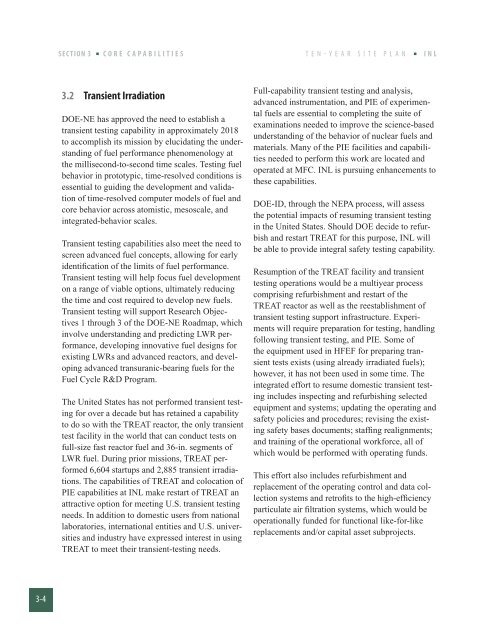2013-2022 TEN-YEAR SITE PLAN - Idaho National Laboratory
2013-2022 TEN-YEAR SITE PLAN - Idaho National Laboratory
2013-2022 TEN-YEAR SITE PLAN - Idaho National Laboratory
Create successful ePaper yourself
Turn your PDF publications into a flip-book with our unique Google optimized e-Paper software.
3-4<br />
SECTION 3 CORE CAPABILITIES<br />
3.2 Transient Irradiation<br />
DOE-NE has approved the need to establish a<br />
transient testing capability in approximately 2018<br />
to accomplish its mission by elucidating the understanding<br />
of fuel performance phenomenology at<br />
the millisecond-to-second time scales. Testing fuel<br />
behavior in prototypic, time-resolved conditions is<br />
essential to guiding the development and validation<br />
of time-resolved computer models of fuel and<br />
core behavior across atomistic, mesoscale, and<br />
integrated-behavior scales.<br />
Transient testing capabilities also meet the need to<br />
screen advanced fuel concepts, allowing for early<br />
identification of the limits of fuel performance.<br />
Transient testing will help focus fuel development<br />
on a range of viable options, ultimately reducing<br />
the time and cost required to develop new fuels.<br />
Transient testing will support Research Objectives<br />
1 through 3 of the DOE-NE Roadmap, which<br />
involve understanding and predicting LWR performance,<br />
developing innovative fuel designs for<br />
existing LWRs and advanced reactors, and developing<br />
advanced transuranic-bearing fuels for the<br />
Fuel Cycle R&D Program.<br />
The United States has not performed transient testing<br />
for over a decade but has retained a capability<br />
to do so with the TREAT reactor, the only transient<br />
test facility in the world that can conduct tests on<br />
full-size fast reactor fuel and 36-in. segments of<br />
LWR fuel. During prior missions, TREAT performed<br />
6,604 startups and 2,885 transient irradiations.<br />
The capabilities of TREAT and colocation of<br />
PIE capabilities at INL make restart of TREAT an<br />
attractive option for meeting U.S. transient testing<br />
needs. In addition to domestic users from national<br />
laboratories, international entities and U.S. universities<br />
and industry have expressed interest in using<br />
TREAT to meet their transient-testing needs.<br />
T E N - Y E A R S I T E P L A N INL<br />
Full-capability transient testing and analysis,<br />
advanced instrumentation, and PIE of experimental<br />
fuels are essential to completing the suite of<br />
examinations needed to improve the science-based<br />
understanding of the behavior of nuclear fuels and<br />
materials. Many of the PIE facilities and capabilities<br />
needed to perform this work are located and<br />
operated at MFC. INL is pursuing enhancements to<br />
these capabilities.<br />
DOE-ID, through the NEPA process, will assess<br />
the potential impacts of resuming transient testing<br />
in the United States. Should DOE decide to refurbish<br />
and restart TREAT for this purpose, INL will<br />
be able to provide integral safety testing capability.<br />
Resumption of the TREAT facility and transient<br />
testing operations would be a multiyear process<br />
comprising refurbishment and restart of the<br />
TREAT reactor as well as the reestablishment of<br />
transient testing support infrastructure. Experiments<br />
will require preparation for testing, handling<br />
following transient testing, and PIE. Some of<br />
the equipment used in HFEF for preparing transient<br />
tests exists (using already irradiated fuels);<br />
however, it has not been used in some time. The<br />
integrated effort to resume domestic transient testing<br />
includes inspecting and refurbishing selected<br />
equipment and systems; updating the operating and<br />
safety policies and procedures; revising the existing<br />
safety bases documents; staffing realignments;<br />
and training of the operational workforce, all of<br />
which would be performed with operating funds.<br />
This effort also includes refurbishment and<br />
replacement of the operating control and data collection<br />
systems and retrofits to the high-efficiency<br />
particulate air filtration systems, which would be<br />
operationally funded for functional like-for-like<br />
replacements and/or capital asset subprojects.

















